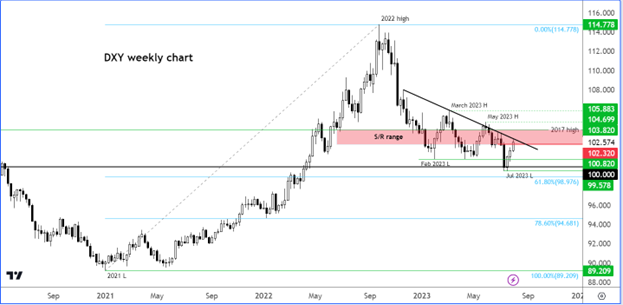All eyes will turn to the US jobs report on Friday, as the market refocuses on Fed policy after the Fitch downgrade of US credit rating caused a risk-off response in the markets, which sent the dollar and long-dated bond yields surging higher this week, states Fawad Razaqzada of Trading Candles.
Once the jobs report is out of the way, the focus will turn to inflation data next week. Together, these macro events could move the markets sharply as they have the potential to influence the Fed’s decision on whether to hike or not next month. Before discussing the macro factors further, let’s take a quick look at the chart of the US Dollar Index (DXY):

Source: TradingView.com
The DXY has recovered quite nicely in the past three weeks, supported by rising bond yields and not-so-weak US data. But around the current levels, it faces several resistance levels which may prevent it from going further higher. The short-term bearish trend line is cutting through an area where the DXY previously struggled. In any case, we are yet to see a higher high. So, all the gains we have seen lately can still be considered a countertrend move, unless we break the high of May at 104.70 at some point down the line.
NFP Report Could Influence Fed Policy Next Month
Employment reports are almost always important anyway, but this one is going to be even more so. Coming in a week before the CPI report, Friday’s jobs data is going to influence Fed’s policy, as Powell has made it quite clear that US monetary policy is now restrictive enough and that the next decision in September would be entirely data-dependent. Until then, we will have two more inflation and a couple of job reports to consider, including this one. While the focus is clearly on inflation as employment is still very strong, any potential weakness in jobs data could cement expectations of a policy hold. But another surprisingly strong employment report would keep the threat of further Fed hikes alive.
A headline jobs growth of 200,000 is expected compared to 209,000 in June, with the unemployment rate seen steady at 3.6%. Meanwhile, Average Hourly Earnings are seen printing +4.2% y/y vs. +4.4% previously
The leading employment indicators we have had this week have been quite mixed. While the ADP private sector payrolls report was strong at 324K, the employment components of both the ISM Services (50.7) and Manufacturing (44.4) PMIs weakened from the previous reading in June. Overall, these pre-NFP leading indicators point to a jobs report roughly in line with expectations.
But the jobs report tends to deviate sharply from expectations, which means the dollar could move sharply. It is also important to consider the whole picture and take into account average hourly earnings when it comes to trading the NFP. On the latter front, we have seen earnings increase by 4.4% year-on-year in April, May, and June 2023. This shows that wage inflation is still going strong, and it is a concern for the Fed. This is especially the case for the services sector—which was also highlighted by the rise in the prices paid index of the ISM services PMI. Another strong showing in wages data would be considered a dollar-bullish jobs report, even if we see a small miss in headline employment.
Inflation Data Next Area of Focus Next Week
Once the jobs report is out of the way, investors will turn their attention towards more inflation data, due in the following week. As mentioned, we will have already had the wage data from the employment report, but CPI is going to be important next Thursday. US inflation has fallen sharply in recent times, printing below-forecast readings in each of the past 4 months. Annual CPI fell to just 3.0% in June from around 6.5% at the start of the year, increasing the likelihood that interest rates have now peaked.
The Fed’s policy decision in September will be entirely data-dependent. Until then, we will have one more inflation and jobs report after this. Any further weakening of CPI could cement expectations of a policy hold.
Don’t Forget the Bond Market Sell-off
The further strengthening of the US dollar so far this week has nothing to do with the Fed’s expected policy decision. It has a lot to do with the sell-off in the US bond market, especially at the long end of the curve. This has been triggered by that rating downgrade by Fitch, causing investors to demand more for the increased risks associated with holding Treasurys. While a US debt default is unthinkable, it could happen at some future point in time. So, we wouldn’t rule out the possibility of further increases in US bond yields in the near term. It will be interesting to watch next week’s $103 billion bond auction. This will tell us a lot about investors’ willingness to hold government debt. That said, the correction potential for the dollar is now high, and investors may soon start selling USD once the dust settles down—and especially if Friday’s jobs report comes in weaker, or inflation data were to surprise to the downside next week.
Trade Ideas
If the employment and inflation data come in lower, I would favor looking for long setups in the EUR/USD, which was testing a key support area near the 1.09 handle, while a stronger set of data would boost the appeal of the USD/CHF. A Goldilocks report is what stock market investors would be looking for—something not too hot to warrant a rate increase, and not too cold to raise recession alarm bells.
To learn more about Fawad Razaqzada visit TradingCandles.com.




















